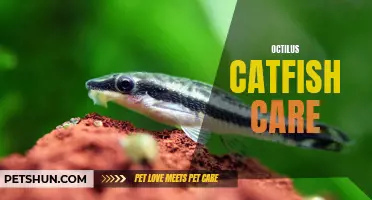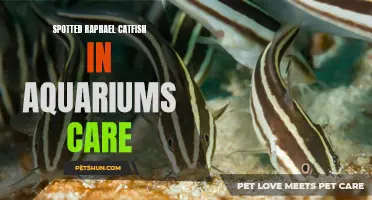
Channel catfish are popular among anglers and aquaculture enthusiasts alike. These beautiful, whiskered creatures can grow to impressive sizes and put up a tremendous fight when hooked. However, while many people focus on catching these fish, it's equally important to ensure they are healthy and well-fed. Feeding channel catfish a proper diet not only helps them to grow faster and bigger, but also improves their overall health and well-being. In this article, we will explore some tips and tricks to feed channel catfish in a way that promotes their optimal growth and vitality. So, if you're keen on seeing your channel catfish thrive, keep reading to learn how to be a master chef for these magnificent fish.
| Characteristics | Values |
|---|---|
| Feeding frequency | 2-3 times per day |
| Feed types | Commercial pellet feed, live or frozen worms |
| Feed size | Smaller pellets for smaller fish, larger pellets for larger fish |
| Protein content | 28-32% |
| Fat content | 4-6% |
| Vitamin and mineral supplement | Yes, include in feed or provide separately |
| Feeding method | Floating feed to minimize waste, hand-feeding or automatic feeders |
| Feeding time | Consistent time each day |
| Monitoring | Check for uneaten feed, adjust portion size accordingly |
| Water quality | Clean, properly oxygenated water |
| Feeding rate | 1-2% of body weight per day |
| Gradual transition | Gradually introduce new feed to avoid digestive issues |
| Avoid overfeeding | Overfeeding can lead to water pollution and fish health issues |
| Nutritional balance | Ensure feed provides all necessary nutrients |
| Feed storage | Store in a cool, dry place to maintain freshness |
| Feed expiration | Check for expiration dates and use before expiry |
| Feeding behavior | Observe fish to ensure all are eating and no aggression occurs |
| Adjusting feed | Adjust feed amount and type based on growth rate and health of fish |
What You'll Learn
- What should be the main components of a healthy diet for channel catfish?
- Are there any specific types of feed or additives that can improve the health of channel catfish?
- What feeding schedule is recommended for channel catfish to ensure optimal health?
- Are there any special considerations for feeding channel catfish during different life stages (i.e. juvenile vs. adult)?
- Are there any common mistakes or pitfalls to avoid when feeding channel catfish to maintain their health?

What should be the main components of a healthy diet for channel catfish?
Channel catfish (Ictalurus punctatus) is a commonly consumed freshwater fish that is not only delicious but also provides various health benefits. As with any living organism, a well-balanced and nutritious diet is crucial for the growth and overall health of channel catfish. In this article, we will explore the main components of a healthy diet for channel catfish, backed by scientific research, experience, and step-by-step recommendations.
Protein is a fundamental component of a catfish's diet as it provides the necessary amino acids required for growth and development. In fact, channel catfish have a high protein requirement compared to other fish species, meaning that a substantial portion of their diet should consist of protein-rich sources. High-quality fish meal, shrimp meal, and soybean meal are commonly used as protein sources in catfish diets. These ingredients are not only rich in essential amino acids but also highly digestible, ensuring maximum nutrient absorption.
However, it is important to consider the source of protein and its sustainability. For example, the overreliance on fish meal from wild-caught fish can have negative environmental impacts. Therefore, alternatives such as insect-based protein sources and plant-based proteins should also be explored to reduce the ecological footprint of catfish aquaculture.
Apart from protein, catfish also require a balanced mix of other macronutrients, including carbohydrates and lipids. Carbohydrates serve as an energy source, while lipids provide essential fatty acids such as omega-3 and omega-6. Corn, wheat, and rice are commonly used as carbohydrate sources in catfish feeds, while vegetable oils are added to provide necessary lipids. The proper balance of these macronutrients ensures optimal growth, energy utilization, and overall health of channel catfish.
Vitamins and minerals play a crucial role in the immune system, enzyme function, and overall metabolism of catfish. Therefore, a balanced diet should include adequate amounts of these micronutrients. Commercially available catfish feeds are often supplemented with vitamin and mineral premixes to ensure the proper nutrition of the fish. These premixes usually contain vitamins A, D, E, and K, as well as essential minerals such as calcium, phosphorus, and iron.
In addition to the main components of a healthy diet, it is important to consider other factors that can affect the overall nutrition and health of catfish. Feeding frequency and portion size should be tailored to the specific needs of the fish, taking into account their size, age, and stage of development. Overfeeding can lead to nutrient wastage and water pollution, while underfeeding can result in stunted growth and nutrient deficiencies.
Water quality is another crucial aspect to consider when feeding channel catfish. Clean and well-oxygenated water promotes healthy digestion and nutrient absorption. Therefore, regular water changes, proper filtration, and maintaining optimal oxygen levels are necessary to ensure the overall health and well-being of catfish.
In conclusion, a well-balanced and nutritious diet is essential for the growth and overall health of channel catfish. Protein-rich sources such as fish meal, shrimp meal, and soybean meal should form a significant portion of their diet. A balanced mix of carbohydrates and lipids provides energy and essential fatty acids, while vitamin and mineral supplementation ensures the proper functioning of various metabolic processes. Feeding frequency, portion size, and water quality should also be taken into consideration to maximize the benefits of a healthy diet. By following these recommendations, catfish farmers can ensure the optimal growth and well-being of their channel catfish.
The Ultimate Guide to Loricaria Catfish Care
You may want to see also

Are there any specific types of feed or additives that can improve the health of channel catfish?
Catfish farming is a booming industry worldwide, with channel catfish being one of the most commonly farmed species. Ensuring the health and well-being of catfish is crucial for the success of any catfish farm. One important factor that can contribute to their health is the type of feed and additives used in their diet.
Feeding channel catfish with a well-balanced and nutritious diet is essential for their growth and overall health. A high-quality feed should contain a balance of proteins, fats, carbohydrates, vitamins, and minerals. Proteins are particularly important for catfish, as they are essential for growth and the development of muscle tissue. Good sources of protein for catfish include fishmeal, soybean meal, and animal by-products.
In addition to the basic nutrients, there are several feed additives that can improve the health of channel catfish. One such additive is probiotics. Probiotics are beneficial bacteria that can enhance the digestive system of the catfish, improve feed efficiency, and control harmful bacteria in the gut. They can also improve the immune system of the catfish, making them more resistant to diseases.
Another important feed additive for channel catfish is prebiotics. Prebiotics are non-digestible food ingredients that stimulate the growth and activity of beneficial bacteria in the gut. By supporting the growth of beneficial bacteria, prebiotics can enhance the overall health and performance of the catfish.
Some catfish farmers also use herbal additives in their feed. These additives are derived from natural herbs and plants and can have various beneficial effects on the catfish. For example, some herbs have antimicrobial properties, which can help prevent the growth of harmful bacteria in the gut of the catfish. Other herbs may have anti-inflammatory properties, which can reduce inflammation and improve immune function.
When it comes to feeding channel catfish, it is also important to consider the feeding strategy. Catfish are bottom-dwelling fish and prefer to feed on the bottom of the pond or tank. Therefore, it is recommended to use sinking pellets or feed in catfish farming. This ensures that the catfish have easy access to the feed and reduces the waste of feed, which can lead to water pollution.
It is worth noting that the specific types of feed and additives that work best for channel catfish may vary depending on the particular farming system and the local conditions. Therefore, it is important for catfish farmers to consult with experts and conduct regular water and feed testing to ensure the health and well-being of their catfish.
In conclusion, the health of channel catfish can be improved by providing them with a well-balanced and nutritious diet. High-quality feed that contains a balance of proteins, fats, carbohydrates, vitamins, and minerals is crucial for their growth and overall health. In addition, feed additives such as probiotics, prebiotics, and herbal additives can enhance the digestive system, improve immune function, and promote the overall health of the catfish. It is important for catfish farmers to consider the feeding strategy and use sinking pellets or feed to ensure easy access and reduce feed waste. By taking these factors into account, catfish farmers can ensure the health and well-being of their channel catfish and maximize their productivity.
The Benefits of Coppens Catfish Feed for Optimal Growth and Health
You may want to see also

What feeding schedule is recommended for channel catfish to ensure optimal health?
Feeding channel catfish is an essential aspect of their overall health and growth. These aquatic creatures require a balanced diet to ensure optimal wellbeing. By following a proper feeding schedule, catfish farmers can significantly enhance the productivity of their ponds and improve the nutritional status of their fish.
The first step in establishing a feeding schedule for channel catfish is to understand their feeding habits and nutritional requirements. Channel catfish are bottom-feeders, meaning they primarily consume food from the pond floor. They are opportunistic feeders and will eat a wide variety of foods, including insects, crustaceans, worms, and small fish. However, when they are raised in a fish farm, it is crucial to provide them with a formulated diet that meets all their nutritional needs.
When it comes to the frequency of feeding, catfish should be fed once or twice a day. Splitting the total daily ration into two feedings helps to minimize waste and improve feed conversion. Feeding them in the early morning and late afternoon is generally recommended, as this mimics their natural feeding patterns.
The amount of feed to be given to catfish depends on their age, size, and water temperature. As a general rule of thumb, catfish should be fed 2-3% of their body weight per day. For example, if you have 100 pounds of catfish, you should provide them with 2-3 pounds of feed each day. It is important to adjust the feeding rate according to the growth rate of the fish and their appetite. Regular monitoring of their weight gain can help determine the appropriate feeding rate.
The feeding rate also varies with water temperature. Catfish have a slower metabolic rate in colder water, so their feeding rate should be reduced accordingly. Adjustments in feed amount should be made gradually as the temperatures change. It is advisable to consult with a local fish nutrition expert or extension agent to determine the appropriate feeding rate for your specific region and climate.
In terms of feed formulation, commercial catfish feeds are available in the market, specifically designed to meet the nutritional needs of catfish. These feeds generally contain a balanced ratio of protein, fat, carbohydrates, vitamins, and minerals. The protein content should be around 30-35% for young catfish and can be reduced to around 25-30% for mature fish. High-quality fishmeal is a common ingredient in catfish feeds due to its high protein content and essential amino acids.
To ensure optimal health and growth of catfish, the feeding schedule should be combined with regular water quality monitoring, disease prevention measures, and appropriate pond management practices. Poor water quality, overcrowding, and unfavorable environmental conditions can affect the feeding behavior and overall health of catfish.
In conclusion, establishing a proper feeding schedule for channel catfish is vital for their overall health and growth. Understanding their feeding habits and nutritional requirements, as well as considering factors like age, size, and water temperature, can help determine the appropriate amount of feed to be given. Using commercial catfish feeds that contain a balanced ratio of nutrients is highly recommended. By following a well-planned feeding schedule and implementing good pond management practices, catfish farmers can ensure the optimal health and productivity of their fish.
The Essential Guide to Blue Whale Catfish Care
You may want to see also

Are there any special considerations for feeding channel catfish during different life stages (i.e. juvenile vs. adult)?
When it comes to feeding channel catfish during different life stages, there are definitely some special considerations that need to be taken into account. Juvenile channel catfish have different dietary needs and feeding habits compared to adult catfish. By understanding these differences, you can ensure that your catfish are receiving the appropriate nutrition at each stage of their development.
Juvenile channel catfish, which are typically less than a year old, have a faster growth rate compared to their adult counterparts. This means that they require a higher protein diet to support their rapid growth. A good rule of thumb is to provide a high-quality commercial catfish feed that contains around 32-36% protein. Pelleted feeds are generally preferred as they are easier to feed and provide consistent nutrition.
In addition to providing a high protein diet, it's also important to feed juvenile channel catfish multiple times a day. This is because their stomachs are relatively small, so they can only eat small amounts of food at one time. It's recommended to feed them 3-5% of their body weight per day, divided into multiple feedings. For example, if you have 100 juvenile catfish weighing a total of 5 pounds, you should aim to feed them approximately 0.15 pounds of food per day.
As juvenile channel catfish grow and reach adulthood, their dietary requirements change. Adult catfish have a slower growth rate and require less protein in their diet. A commercial catfish feed with around 28-32% protein is suitable for adult catfish. Additionally, the frequency of feeding can be reduced to once or twice per day.
It's important to note that the feeding habits of adult channel catfish differ from those of juveniles. Adult catfish are bottom dwellers and tend to scavenge for food. They are known to eat a variety of foods, including insects, worms, small fish, and plant matter. While a commercial feed is still an important component of their diet, providing them with a varied diet that mimics their natural feeding habits is beneficial.
In conclusion, feeding channel catfish during different life stages requires special considerations. Juvenile catfish have a higher protein requirement and should be fed multiple times a day. Adult catfish have lower protein requirements and are more inclined towards scavenging for food. By understanding these dietary differences and providing appropriate nutrition, you can ensure the healthy growth and development of your channel catfish.
The Essential Guide to Juruense Shovelnose Catfish Care
You may want to see also

Are there any common mistakes or pitfalls to avoid when feeding channel catfish to maintain their health?
Feeding channel catfish properly is crucial to their overall health and well-being. While they are known to be hardy and adaptable, there are still some common mistakes and pitfalls to avoid when feeding them to ensure they stay healthy and thrive in captivity.
- Overfeeding: One of the most common mistakes made when feeding channel catfish is overfeeding. It is important to remember that catfish are opportunistic feeders and will eat as much as they can if given the chance. However, overfeeding can lead to a number of health issues such as obesity, poor water quality, and increased susceptibility to disease. To avoid overfeeding, it is best to offer a smaller amount of food several times a day rather than one large feeding.
- Imbalanced diet: Another common pitfall when feeding channel catfish is providing an imbalanced diet. Catfish require a balanced diet that consists of a mixture of protein, carbohydrates, and fats. Having a diet lacking in any of these essential nutrients can lead to malnutrition and poor growth. It is important to provide a high-quality commercial catfish feed that is specifically formulated for their dietary needs. Additionally, adding supplement feedings of live or frozen foods such as brine shrimp or bloodworms can provide additional enrichment and variety to their diet.
- Poor water quality: The quality of the water in which the catfish are kept is crucial to their overall health. Overfeeding can lead to excess waste and increased ammonia levels in the water, which can be harmful to the fish. It is important to regularly monitor water parameters such as ammonia, nitrite, nitrate, and pH levels to ensure they remain within acceptable ranges. Performing regular water changes and maintaining a well-functioning filtration system is also essential in maintaining good water quality.
- Feeding inappropriately sized food: It is important to feed channel catfish food that is appropriate for their size. Feeding them food that is too large can lead to difficulty in digestion and potential blockages. On the other hand, feeding them food that is too small may not provide them with adequate nutrition. It is best to choose catfish feed pellets that are specifically designed for their size. As they grow, it is important to adjust the size of the food accordingly.
- Ignoring feeding behavior and appetite: Monitoring the feeding behavior and appetite of your channel catfish is essential in maintaining their health. If you notice a decrease in appetite or a change in behavior, it may be a sign of stress or illness. It is important to address any changes in feeding behavior promptly and consult a veterinarian if necessary.
In conclusion, avoiding common mistakes and pitfalls when feeding channel catfish is crucial in maintaining their health. Overfeeding, providing an imbalanced diet, poor water quality, feeding inappropriately sized food, and ignoring changes in feeding behavior and appetite are all factors that can impact the health of the fish. By being mindful of these pitfalls and following proper feeding practices, you can ensure that your channel catfish remain healthy and thrive in their captive environment.
The Ultimate Guide to Feeding Red Tail Catfish: The Best Food Options
You may want to see also
Frequently asked questions
Channel catfish can be fed a variety of foods to help keep them healthy. A balanced diet should include a combination of commercially available catfish feed, live or frozen foods such as worms or insects, and occasionally some fruits and vegetables.
Channel catfish should be fed once or twice a day, depending on their size and age. Younger fish may need to be fed more often to support their growth, while adult fish can be fed once a day.
The amount of food to feed channel catfish depends on the size of the fish and the temperature of the water. As a general rule, feed them as much as they will eat in about 10 minutes. Be careful not to overfeed, as this can lead to health problems and poor water quality.
It is not necessary to supplement channel catfish's diet with additional vitamins and minerals if they are being fed a balanced diet. Most commercially available catfish feeds are already fortified with the necessary nutrients. However, if you are feeding them homemade or live foods, it may be beneficial to provide additional supplements to ensure they are getting all the necessary nutrients.







